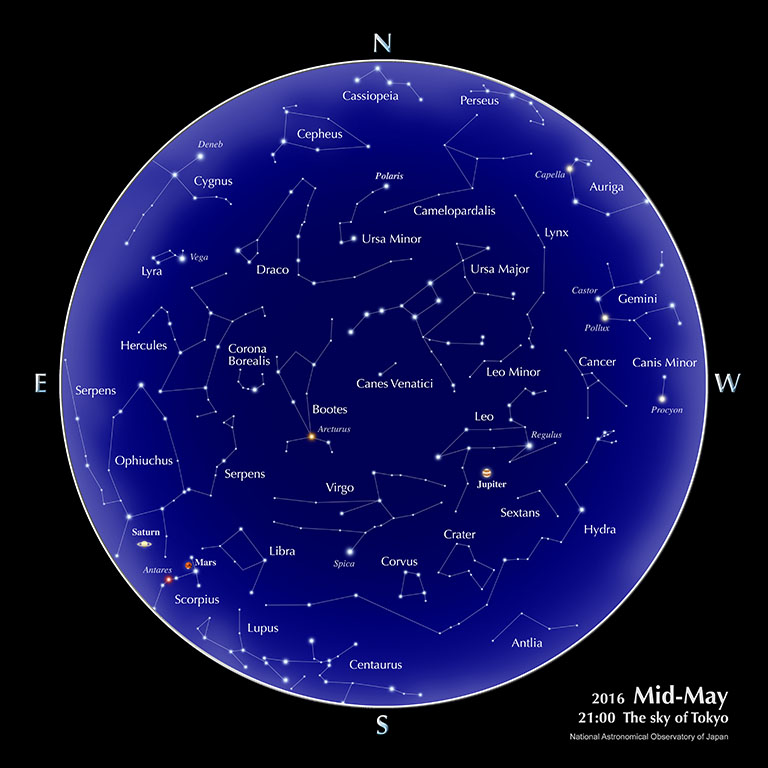Astronomical Information | 2016 | May
The sky of Tokyo

Calendar (May)
| 3 | Constitution Memorial Day [Kenpou-Kinen-bi] (national holiday) |
| 4 | Greenery Day [Midori-no-hi] (national holiday) |
| 5 | Children’s Day [Kodomo-no-hi] (national holiday) |
| 6 | Eta Aquarid Meteor Shower peaks around this time (The best visibility will be before dawn for the 2~3 days around this date. About 5 meteors per hour are expected. Because there is no moonlight, the conditions are very good.) |
| 7 | New Moon |
| 9 | Transit of Mercury across the Solar Disk (not visible from Japan) Reference: Local Prediction of the Transit of Planet |
| 10 | Mercury at inferior conjunction/ Jupiter at stationary point |
| 14 | First Quarter Moon |
| 22 | Full Moon/ Mercury at stationary point/ Mars at opposition |
| 29 | Last Quarter Moon |
| 31 | Mars makes its closest approach to Earth (Distance 0.503 au) |
The days for the peak activities of the meteor showers are based on the predictions of IMO (International Meteor Organization).
Planets
- Mercury
- Mercury reaches inferior conjunction on the 10th. Mercury’s apparent position is close to the Sun, making observations difficult.
- Venus
- Venus’s apparent position is close to the Sun, so it is not suited for observations.
- Mars
- Mars moves from the constellation Scorpio to the constellation Libra. From Tokyo, it can be seen in the south-eastern sky around 21:00. Mars reaches opposition on the 22th and makes its closest approach to Earth on the 31st, presenting us with an opportunity to observe it. Its brightness is -1.5 magnitude to -2.1 magnitude.
- Jupiter
- Located in the constellation Leo, Jupiter can be seen high in the southern to south-western sky in the evening. Its brightness is -2.3 magnitude to -2.1 magnitude.
- Saturn
- Located in the constellation Ophiuchus, Saturn rises in the eastern sky around 21:00 at the start of the month and around 20:00 at the end of the month, as seen from Tokyo. It reaches opposition on June 3, presenting us with an opportunity to observe it. Its brightness is -0.2 magnitude to 0.0 magnitude.
Source: Ephemeris Computation Office, NAOJ
With the “Sky Viewer” you can easily explore the appearance of a typical urban night sky (planets and constellations are visible).The Celestial Phenomena section of the glossary explains the planetary phenomena terms: greatest elongation, opposition, conjunction, stationary, etc.